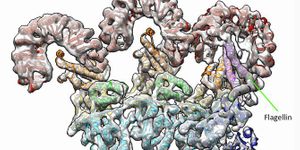L to H mode transition: the key mechanism to fusion success
Fusion experiment: MAST Plasma. Credit: CulhamFusionEnergy
Francois Ryter from Germany’s Max Planck Institute for Plasma Physics has won the IAEA’s 2017 Nuclear Fusion Journal Prize for experimental work elucidating a mechanism that can trigger a fusion plasma to a state that allows the fusion device to operate under high performance.
To produce energy from fusion, scientists must control the temperature, density and lifespan of the plasma fuel. Since all deuterium/tritium fuelled fusion takes place at 150 million degrees Celsius, the two variables that can be controlled to produce fusion are plasma density and lifespan.
At one end of the spectrum is low density, long lifespan fusion, in which the low density produces a relatively small number of energy producing collisions, but the plasma is long lived enough to achieve sufficient interactions to generate energy. Because the plasma is held stable (confined) for these long periods using magnetic fields, this technique is referred to as magnetic confinement fusion. The International Thermonuclear Experimental Reactor (ITER) uses this approach in its tokamak to generate fusion.
At the other end of the spectrum is very high-density plasma with very short lifespans, referred to as inertial confinement fusion. Using extremely rapid compression to heat a capsule of fuel to fusion temperatures, inertial confinement fusion takes place in a matter of nanoseconds and produces a short-lived burst of energy. The National Ignition Facility is the world’s largest inertial confinement fusion research facility.
Initiating and sustaining fusion takes a lot of energy and a key issue is being able to achieve the condition in which the fusion output power exceeds the auxiliary input power supplied from outside to sustain the reaction. The operation of ITER in so called high (H)-mode is critical to achieving this condition.
The award-winning paper has shown that, of the several factors that had been considered as potential triggers for the transition from the low (L)-mode confinement state of the device to H-mode, ion heat flux is key. This video shows the transition of the plasma from L-mode to H-mode inside a tokamak. The transition occurs at around 0:22.
The findings can improve the capability to predict the amount of input power required to operate the device in H-mode. Filling this kind of gap in the understanding of magnetic confinement plasma physics can facilitate the preparation for the operation of future fusion reactors for energy production.
Source: IAEA








